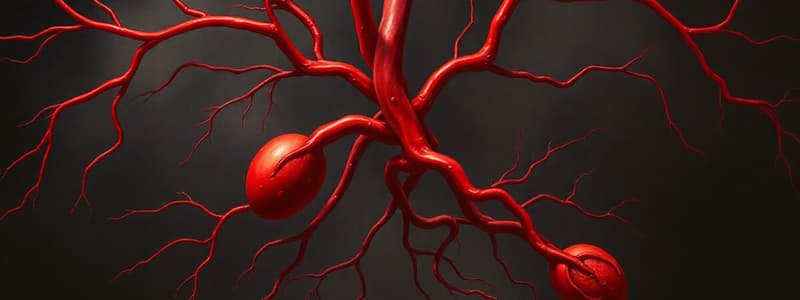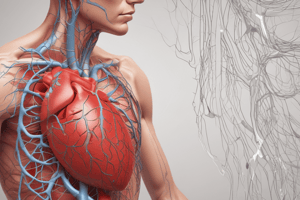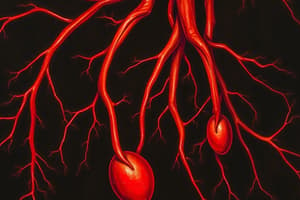Podcast
Questions and Answers
What is the normal amount of stroke volume (SV) pumped out of the left ventricle during each systolic cardiac contraction?
What is the normal amount of stroke volume (SV) pumped out of the left ventricle during each systolic cardiac contraction?
- 100 ml
- 70 ml
- 90 ml
- 80 ml (correct)
Decreased arterial compliance generally results in a narrowed pulse pressure.
Decreased arterial compliance generally results in a narrowed pulse pressure.
False (B)
In the formula SV = EDV - ESV, what does SV stand for?
In the formula SV = EDV - ESV, what does SV stand for?
Stroke Volume
As a person ages, there is a decrease in _____ in the aorta, leading to decreased arterial compliance.
As a person ages, there is a decrease in _____ in the aorta, leading to decreased arterial compliance.
Match the following types of blood pressure measurements with their characteristics:
Match the following types of blood pressure measurements with their characteristics:
What happens to pulse pressure when stroke volume increases?
What happens to pulse pressure when stroke volume increases?
A widened pulse pressure is typically characterized by an increase in systolic pressure.
A widened pulse pressure is typically characterized by an increase in systolic pressure.
What is the normal arterial compliance in ml/mmHg?
What is the normal arterial compliance in ml/mmHg?
What is the primary determinant of pulse pressure?
What is the primary determinant of pulse pressure?
As a person ages, arterial compliance typically increases.
As a person ages, arterial compliance typically increases.
What is the formula for calculating pulse pressure?
What is the formula for calculating pulse pressure?
Pulse Pressure = Systolic BP - _________.
Pulse Pressure = Systolic BP - _________.
During diastole, if the aorta is rigid, what happens to blood flow to the capillaries?
During diastole, if the aorta is rigid, what happens to blood flow to the capillaries?
What effect does atherosclerosis have on the aorta's ability to distend?
What effect does atherosclerosis have on the aorta's ability to distend?
Match the following parameters with their descriptions:
Match the following parameters with their descriptions:
No stroke volume is pushed forward by the aorta to the capillaries during systole if the aorta is rigid.
No stroke volume is pushed forward by the aorta to the capillaries during systole if the aorta is rigid.
What is the effect of increased hematocrit on viscosity in large vessels?
What is the effect of increased hematocrit on viscosity in large vessels?
Total resistance significantly increases when multiple resistors are in parallel.
Total resistance significantly increases when multiple resistors are in parallel.
What phenomenon explains the reduced impact of viscosity in small vessels?
What phenomenon explains the reduced impact of viscosity in small vessels?
In patients with ___, the hematocrit is low which leads to decreased viscosity and total peripheral resistance.
In patients with ___, the hematocrit is low which leads to decreased viscosity and total peripheral resistance.
During blood pressure measurement, what is indicated by the first Korotkoff sound?
During blood pressure measurement, what is indicated by the first Korotkoff sound?
Match the condition with its effect on total peripheral resistance (TPR):
Match the condition with its effect on total peripheral resistance (TPR):
How does aging affect vascular health regarding compliance?
How does aging affect vascular health regarding compliance?
A decrease in stroke volume will typically increase pulse pressure.
A decrease in stroke volume will typically increase pulse pressure.
Flashcards
Arterial Compliance
Arterial Compliance
The ability of an artery to expand and contract in response to changes in blood pressure.
Stroke Volume (SV)
Stroke Volume (SV)
The amount of blood pumped out of the left ventricle with each heartbeat.
Pulse Pressure
Pulse Pressure
The difference between systolic and diastolic blood pressure.
Normal Pulse Pressure
Normal Pulse Pressure
Signup and view all the flashcards
Widened Pulse Pressure
Widened Pulse Pressure
Signup and view all the flashcards
Narrowed Pulse Pressure
Narrowed Pulse Pressure
Signup and view all the flashcards
Korotkoff Sounds
Korotkoff Sounds
Signup and view all the flashcards
Hemorrhage Effect on Pulse Pressure
Hemorrhage Effect on Pulse Pressure
Signup and view all the flashcards
Rigid Artery
Rigid Artery
Signup and view all the flashcards
Systolic BP
Systolic BP
Signup and view all the flashcards
Diastolic BP
Diastolic BP
Signup and view all the flashcards
Atherosclerotic aorta
Atherosclerotic aorta
Signup and view all the flashcards
Pulse pressure calculation
Pulse pressure calculation
Signup and view all the flashcards
Viscosity of Blood
Viscosity of Blood
Signup and view all the flashcards
Hematocrit and Viscosity
Hematocrit and Viscosity
Signup and view all the flashcards
Fahraeus-Lindqvist Effect
Fahraeus-Lindqvist Effect
Signup and view all the flashcards
Hematocrit's Impact on TPR
Hematocrit's Impact on TPR
Signup and view all the flashcards
Polycythemia and TPR
Polycythemia and TPR
Signup and view all the flashcards
Anemia and TPR
Anemia and TPR
Signup and view all the flashcards
Mean Arterial Pressure (MAP)
Mean Arterial Pressure (MAP)
Signup and view all the flashcards
Study Notes
Hemodynamics and Venous Return
- Homeostasis is maintained by the body's regulating mechanisms to create an optimal internal environment for cell survival.
- Systemic Circulation carries oxygen-rich blood from the heart to body tissues and returns deoxygenated blood to the heart. About 84% of blood volume circulates in this system.
- Pulmonary Circulation carries deoxygenated blood to the lungs for oxygenation and returns oxygenated blood to the heart. About 16% of blood volume is in this circuit.
- The circulatory system transports oxygen, nutrients, waste products, and hormones throughout the body.
Circulatory System and Blood Vessels
- Blood vessels distribute and exchange substances (nutrients/waste); have three layers: tunica intima, tunica media, and tunica externa/adventitia.
- Arteries have thick walls with elastin for stretching and recoil, and smooth muscle for constriction/vasodilation.
- Elastic Arteries (e.g., aorta) have high elastin content near the heart, conducting large volumes of blood.
- Muscular Arteries (distributing arteries) play a role in regulating vasoconstriction/vasodilation, farther from the heart where blood pressure has decreased, and contain less elastin.
- Arterioles are small, have significant resistance to blood flow, and their diameter regulates blood flow into capillaries via precapillary sphincters.
- Capillaries are the sites of gas and nutrient exchange with tissues; walls contain a single layer of cells for efficient diffusion.
- Venules collect blood from capillaries and merge into veins.
- Veins are capacitance vessels; have thinner walls, larger lumens, and venous valves preventing backflow.
Hemodynamics
- Velocity is the distance a particle of fluid travels per unit time; flow rate is volume of fluid per unit time.
- Velocity is inversely proportional to cross-sectional area; blood velocity is slowest in capillaries due to their large total cross-sectional area.
- Bernoulli's Principle: the sum of potential, kinetic, and pressure energy per unit mass of an incompressible fluid remains constant. Increased velocity results in a decrease in lateral pressure.
- Pressure is exerted laterally against the vessel walls; higher velocity is related to pressure difference.
- Poiseuille's Law: fluid flow through a vessel is directly proportional to the fourth power of the radius and pressure difference, and inversely proportional to viscosity and length.
Blood Pressure
- Blood pressure (BP) is the force of blood against vessel walls, measured as systolic/diastolic pressure.
- Mean arterial pressure (MAP) is the average pressure during a cardiac cycle; a better indicator of tissue perfusion than systolic pressure.
- Pulse Pressure is the difference between systolic and diastolic pressure.
Regulation of Arterial Blood Pressure
- Intrinsic Control: Local factors like myogenic mechanisms, endothelial factors (nitric oxide, endothelin), and tissue metabolites regulate local blood flow.
- Extrinsic Control (Humoral): The renin-angiotensin-aldosterone system (RAAS) and other hormones regulate systemic arterial blood pressure and volume long-term.
- Extrinsic Control (Neural): The autonomic nervous system regulates short-term blood pressure through the sympathetic and parasympathetic nervous systems.
- Baroreceptors: pressure sensors; changes in blood pressure trigger reflex changes in heart rate and vascular resistance.
- Chemoreceptors: detect changes in blood pH, oxygen, and carbon dioxide levels; trigger compensatory mechanisms to maintain homeostasis.
Venous Return
- Venous system: has high capacitance; large reservoir for circulating blood (70%); adjust volume of blood returning to the heart; distensible and has low resistance.
- Venous Compliance: veins' ability to stretch and hold blood volumes; inversely related to venous pressure.
- Venous Valves: prevent backflow and facilitate one-way blood flow toward the heart.
- Factors affecting venous return: skeletal muscle pump, respiratory pump, sympathetic vasoconstriction, cardiac suction effect, and gravity.
- Central Venous Pressure (CVP): pressure in the large veins near the heart; it reflects volume load on the right side of the heart.
- Pulmonary Venous Pressure (PVP): pressure within the pulmonary veins; it affects left-sided filling pressures and is a part of the pulmonary circulation.
Studying That Suits You
Use AI to generate personalized quizzes and flashcards to suit your learning preferences.





